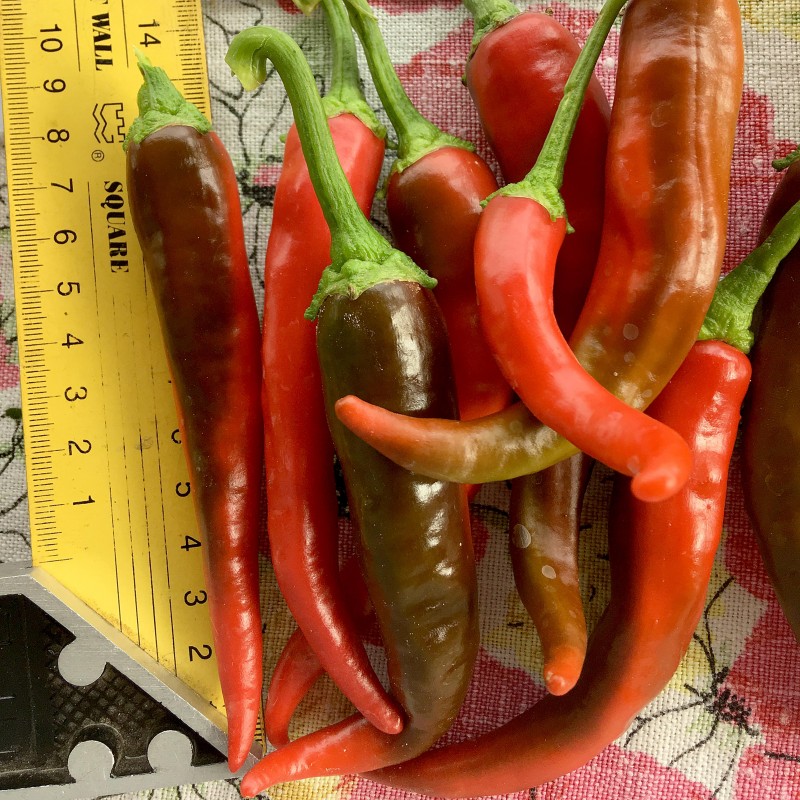Spicy peppers including cayenne peppers have been cultivated for centuries. In South America, archaeologists discovered specimens of peppers dating back to 2500 BC.
The cayenne is one of the most popular peppers used in the Western hemisphere. The name of the pepper is taken from the city of Cayenne in French Guiana, from where the pepper originates and where its first documented uses were found.
Cayenne peppers are usually used as a dried spice, which is made by drying and grinding the peppers or pulping and baking them into cakes, which are then ground to produce the spice.
Cayenne peppers can also be used fresh in dishes, but are a little harder to find outside of the powdered form.
Cayenne peppers were brought to Europe following the discovery of the New World. Spanish scholars were sent to regions in Central America and Mexico to observe the native populations.
These scholars noted that spicy peppers, cayenne included, formed a large part of the locals’ diets. One noted scholar wrote that Peruvian Indians valued hot peppers as a staple part of their meals.
Cayenne peppers are used liberally in many dishes throughout Southeast Asia and Africa. In Ethiopia, the national dish consists of crushed cayenne pods mixed with beans or peas to produce a spicy paste.
Cayenne peppers have been used for thousands of years in traditional medicine. In the West Indies, indigenous populations ate cayenne peppers as a preventative for yellow fever. (Source)
In Ancient Maya society, cayenne pepper was used to as a treatment for a variety of ailments. Cayenne pepper powder was used for wounds and scratches to prevent infection.
Cayenne pepper was used in small doses to treat digestive issues and to promote the swift digestion of other healing herbs. Some forms of traditional medicine use cayenne pepper as an ingredient in soothing muscle rubs. (Source)
The spiciness or heat of any pepper is measured according to the Scoville Scale. This scale was developed in the early 20th century by Wilbur Scoville.
Originally, peppers were accorded a number on the scale according to a water dilution test. For example, extract of jalapeno pepper had to be diluted 8,000 times to be devoid of any heat.
Today, the amount of capsaicin in a pepper is analyzed to measure their pungency and subsequent rating. Cayenne peppers are ranked at 50,000 Scoville units, considered in the middle range of heat. (Source)
Nutritional Profile
Cayenne peppers are rich in nutrients, vitamins and minerals. Additionally, they are potent antioxidants.
One teaspoonful of powdered cayenne pepper is worth 17 calories. This same serving contains the following nutrients:
- Fat (1 gram)
- Sugar (1 gram)
- Protein (1 gram)
- Carbohydrates (1 gram)
- Dietary fiber (1 gram)
- Sodium (2 milligrams)
One serving of cayenne pepper powder contains daily value percentages for the following vitamins and minerals:
- Vitamin A (44 percent)
- Vitamin E (8 percent)
- Vitamin C (7 percent)
- Vitamin B6 (6 percent)
- Manganese (5 percent)
- Vitamin K (5 percent)
- Potassium (3 percent) (Source)
Cayenne pepper contains capsaicin, the compound responsible for making hot peppers spicy. Capsaicin possesses antibacterial, anti-carcinogenic and analgesic properties. (Source)
Health Benefits
In traditional medicine, cayenne pepper is used to treat a variety of internal and external issues. Studies have confirmed cayenne pepper’s beneficial effects on certain conditions.
One of the most common traditional remedies for digestive issues is cayenne pepper. Consuming cayenne pepper, powdered or whole, helps promote saliva production.
Saliva contributes towards better digestion and reduces halitosis (bad breath). Similarly, cayenne pepper stimulates the production of gastric juices essential for digestion.
Individuals suffering from ulcers were generally advised to avoid cayenne pepper. The capsaicin found within cayenne pepper was believed to worsen gastric ulcers.
However, recent studies have revealed that cayenne pepper can be beneficial rather than detrimental when it comes to ulcers. Cayenne pepper inhibits the secretion of acids in the stomach.
Simultaneously, cayenne pepper increases alkali levels. It also stimulates mucosal secretions and alkali, which help to heal and prevent ulcers.
Consuming cayenne pepper can promote circulation and encourage fibrinolytic activity. This can reduce your risk of blood clots and promote heart health overall.
The capsaicin found in cayenne peppers can contribute towards clearing lipid deposits in the arteries. As an added benefit, capsaicin encourages blood vessels and arteries to dilate and widen.
These circulation-boosting properties are useful when it comes to detoxing. Cayenne pepper improves your body’s ability to flush toxins and bacteria.
Eating cayenne pepper can heighten your body temperature and speed up your metabolism. These effects are helpful when you are fighting a flu, as are the vitamins and minerals cayenne pepper contains.
Cayenne pepper can contribute towards weight loss over time. A study revealed that individuals who ate cayenne pepper first thing in the morning had decreased appetite during the day.
Since cayenne pepper has anti-inflammatory abilities, it can reduce bloating. Its anti-inflammatory compounds can also reduce the symptoms of certain allergies.
Applied externally on the skin, cayenne pepper poultices, creams and gels can reduce pain. When you are in pain, a chemical called substance P transmits pain messages to your brain.
Studies have revealed that cayenne pepper can reduce the amount of substance P produced. It has been used to treat pain due to nerve pain caused by diabetes.
Cayenne pepper is also effective in treating muscle and joint pain. Similarly, it can alleviate pain due to different types of arthritis.
Cayenne pepper has potent antibacterial properties. Studies have shown it is effective in combating yeast infections caused by the Candida fungus.
Cayenne pepper is effective against 15 other types of fungus. It can prevent fungal pathogens from forming, and kill or reduce existing fungal pathogens.
Cayenne pepper may have potential as an anti-cancer agent. A study revealed that capsaicin can inhibit cancer cell growth and prevent formation of cancer cells. (Source)

